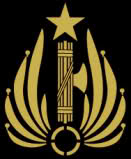Libyan Royal Guard (Kingdom of Italy)
| Libyan National Republican Guard | |
|---|---|
|
الحرس الجمهوري Ḥaris al-‘Lybyia al-Jamhariyya | |
 The M.V.S.N. emblem | |
| Active | 1955 - present |
| Branch | National Republican Guard |
| Role | Defence force |
| Size | 25,000 |
| Part of | National Republican Guard |
| Headquarters | Tripoli |
| Commanders | |
| Current commander |
Maj. Gen. Nouri Abusahmain |
The Libyan National Republican Guard (Arabic: الحرس الجمهوري, Ḥaris al-‘Lybyia al-Jamhariyya, H.L.J.) is the branch of the National Republican Guard tasked to guard and protect the internal security of the Libyan Autonomous Social Republic. The Ḥaris al-Jamhariyya, as it is commonly referred to, is the oldest and the largest of the Republican Guards of the Autonomous Republics of the Italian Empire, sometimes being regarded as a true national army.
Contents
History
The Libyan National Republican Guard descends directly from the Libyan MVSN; in 1955, only seven years after the establishment of the Italian G.N.R., the Libyan Colonial Militia was merged with other PNF security services, and the Ḥaris al-‘Lybyia al-Jamhariyya was established, even despite the lack of Republican status of the then-colony.
Until recently, the Libyan G.N.R. was commanded by Italian officers, both born and grown up in Libya and coming from Italy. The current Commander is Major General Nouri Abusahmain, the second Commander of Libyan descent after Muammar Muhammad Abu Minyar al-Gaddafi, who was also the first officer of Libyan descent to hold a General rank after being the Chief of Staff with the rank of Colonel; under al-Gaddafi long tenure (1983-2008), Libyan officers could afford for the first time also General ranks. The Ḥaris al-‘Lybyia al-Jamhariyya was deeply involved in the suppression of the UK/USA-backed 2011 revolt and in the subsequent pacification and fight to migration flows from Subsaharian Africa to Northern Africa and the Mediterranean Sea.
In recent years, the H.L.J. provided several instructors and volunteers to the loyalist side of the Syrian Civil War.
Organization
The H.L.J. is a military force deployed in Libya; the operational forces are organized on two Divisions: the Line Division and the Facilities Defence Division. The main force is the Line Division, in turn based on the Divisional units and five Regiments. Regiments are responsible for specialized training and personnel administration, while subordinate battalions are operationally framed within three Brigades (having Arabic names). Alongside the line Division, also a Facilities Defence Division operates on territorial basis.
Top and support organization
The command and support organization is framed within the H.L.J. Central Command; it groups the General Staff, the Logistics Command, the Training Command and the Support Services Command (all organized at the Brigade level), while administrative duties are dealt with by the Libyan M.V.S.N. The H.L.J. Central Command consists of:
- General Staff;
- General Staff Battalion;
- Logistics and Communications Command;
- Training Command;
- Support Services Command.
Line Division
The Line Division is organized on the Divisional Staff, the Support Battalions and on five Regiments. The Division consists of:
- Divisional Staff
- Command Battalion "Libia";
- Support Battalion (Medical, Military Police, Supplies, etc.) "Cirenaica";
- Communications Battalion "Tripolitania";
- Training Battalion "Tunisia";
- 1st "Mussolini" Cavalry Regiment;
- 2nd "Al-Saiqa" Paratroopers Regiment (directly descending from "Fanti dell'Aria" Paratroopers Battalion);
- 3rd "Italo Balbo" Mechanized Infantry Regiment;
- 4th "Ghibli" Mechanized Infantry Regiment;
- 5th "El Alamein" Mobile Artillery Regiment.
Operational Brigades
The Line Division is operationally organized into three small Brigades, deployed across the country in few bases in the interior, ready for employment. Each Brigade has a support unit, grouping all support services, a Cavalry Squadrons Group (Battalion-sized unit), two Infantry Battalions and one Artillery Group, drawn from Regiments.
- 1st Brigade "Ṭarābulus"
- 1st Support Unit "Ṭarābulus"
- 1st Cavalry Squadrons Group "Faras"
- 1st Mechanized Infantry Battalion "Musha" (1/3)
- 2nd Mechanized Infantry Battalion "Qanas" (2/3)
- 1st Mobile Artillery Group "Medjerda"
- 2nd Brigade "Banghāzī"
- 2nd Support Unit "Banghāzī"
- 2nd Cavalry Squadrons Group "Diastarih"
- 3rd Mechanized Infantry Battalion "al-Faris" (3/3)
- 4th Mechanizd Infantry Battalion "Ansar" (4/4)
- 2nd Mobile Artillery Group "Targhalat"
- 3rd Brigade "Tūnis"
- 3rd Support Unit "Tūnis"
- 3rd Cavalry Squadrons Group "Kursr"
- 5th Mechanized Infantry Battalion "Mushat al-Khiala" (5/4)
- 6th Mechanized Infantry Battalion "Jund al-Musadama" (6/4)
- 3rd Mobile Artillery Group "Turghut"
2nd "Al-Saiqa" Paratroopers Regiment
The 2nd "Al-Saiqa" Paratroopers Regiment is both a training/administrative organization and an operational unit, being directly subordinated to the Libyan National Republican Guard commander and his Staff. The Regiment historically descends from the famed "Fanti dell'Aria" Paratroopers Battalion, established by Italo Balbo in 1939. Nowadays, the Regiment shares its training with Italian Army and G.N.R. paratroopers and it is employed to carry out special missions. The Regiment consists of:
- Command;
- Command and Services Company "Al-Saiqa":
- 1st Paratroopers Battalion "Nusar";
- 2nd Paratroopers Battalion "Asad";
- 3rd Paratroopers Battalion "al-Nnamr".
Facilities Defence Division
The Facilities Defence Division is mainly tasked with securing and protecting the oil infrastructures to prevent interdiction and theft. It is organized into a Divisional Staff and four Brigade Commands with territorial responsibilities:
- Facilities Defence Division Staff;
- 4th Brigade "Tunisi" (headquartered in Tunis);
- 5th Brigade "Tripoli" (headquartered in Tripoli);
- 6th Brigade "Bengasi" (headquartered in Benghazi);
- 7th Brigade "Fezzan" (headquartered in Sabha).
Each Command has three light infantry battalions and one mobile emergency battalion assigned.
Uniforms and insignia
Libyan G.N.R. Legionnaires wear their own uniform: green jacket and trousers and matching cap. The blackshirt and the Fascist Eagle are common among all M.V.S.N. branches. Aside of uniform colours, both the cloths' cuts and rank insignia are the same across the Italian Empire.

